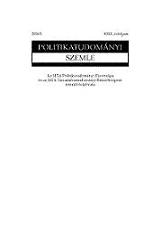AZ ÚJ PARLAMENTI PÁRTOK SZAVAZÓBÁZISÁNAK JELLEMZŐI BUDAPEST PÉLDÁJÁN
VOTERS OF THE NEW PARLIAMENTARY PARTIES: THE BUDAPEST CASE
Author(s): Balázs SzabóSubject(s): Politics / Political Sciences
Published by: MTA Politikai Tudományi Intézete
Keywords: Green; extreme right; voter behaviour; Budapest
Summary/Abstract: In 2010, two new parties, the green LMP and the far-right Jobbik gained seats in the Hungarian parliament with the support of a quarter of the voters. There are strong similarities between the spatial feature of their voting base and that of their Western counterparts. The greens are strong in the capital and other big cities, including their suburban zone, while the far-right supporters are mainly located in the deprived industrial regions of the country. The article focuses on Budapest where the fi gures for party preferences are available at the level of electoral wards, thus a detailed picture of the voters’ social structure can be drawn. The green voters are concentrated in the inner quarters, the villa quarters with high prestige and the newly built parts of the city, i.e. in residential areas inhabited by upper classes, mobile youth, and intellectuals. The far-right supporters live in the old outer working class zones, some large high-rise housing estates, and the lowest prestige inner city quarters. These differences between the geographical and social structure of the two parties’ voting basefi t remarkably well the pattern that is typical in Western cities. This similarity seems to indicate the emergence of the new materialist-post-materialist cleavages in Hungary, too, especially in the case of the green voters. Most of them belong to the new young middle class committed to post-materialist values. By contrast, the Jobbik gains its supporters from the downgrading lower class, those who are responsive to its racist, anti-democratic, and anti-establishment rhetoric.
Journal: Politikatudományi Szemle
- Issue Year: 2013
- Issue No: 3
- Page Range: 92-116
- Page Count: 24
- Language: Hungarian

